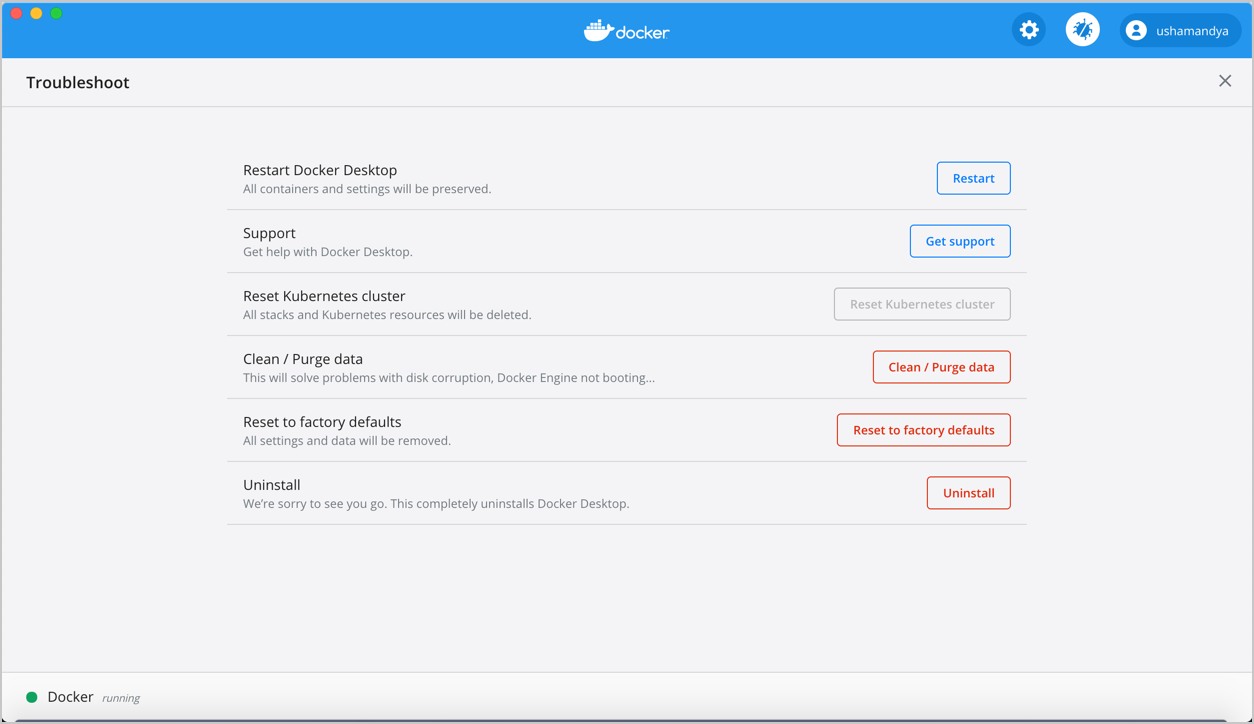

- #DOCKER DESKTOP NOT STARTING INSTALL#
- #DOCKER DESKTOP NOT STARTING SOFTWARE#
- #DOCKER DESKTOP NOT STARTING MAC#
This allows containers to easily talk to each other without knowing their internal IP addresses. Inside Docker Desktop there are multiple DNS servers:ĭNS requests from containers are first processed by a server inside dockerd, which recognises the names of other containers on the same internal network.

The next section describes how Docker Desktop uses the Domain Name System (DNS) to give human-readable names to network services. TCP/IP addresses are difficult to work with directly. These services can be addressed directly via a virtual IP address / DNS name, or indirectly by matching on outgoing traffic and redirecting dynamically, depending on the configuration.

In addition to low-level TCP/IP, vpnkit has a number of built-in high-level network services, such as a DNS server ( mirage/ocaml-dns) and HTTP proxy ( mirage/cohttp). If the connect() is rejected, vpnkit replies with a TCP RST (reset) packet which causes the connect() inside Linux to return an error. In Linux the connect() succeeds and data is proxied in both directions ( mirage/mirage-flow). If the connect() succeeds, vpnkit replies to Linux with a TCP SYNchronize packet which completes the TCP handshake. Vpnkit observes the SYNchronize flag and calls connect() itself from the host. When a container calls connect() to establish a TCP connection, Linux sends a TCP packet with the SYNchronize flag set. This stack acts as the peer of the one in Linux, accepting connections and exchanging packets. When vpnkit sees an outgoing packet with a new destination IP address, it creates a virtual TCP/IP stack to represent the remote machine ( mirage/mirage-tcpip). Once it has received the ARP response it is ready to send a packet to the Internet. Once the VM receives the DHCP response containing the VM’s IP address and the IP of the gateway, it sends an ARP request to discover the ethernet address of the gateway ( mirage/arp). Vpnkit contains a virtual ethernet switch ( mirage-vnetif) which forwards the request to the DHCP ( mirage/charrua) server.
#DOCKER DESKTOP NOT STARTING MAC#
The ethernet frame containing the request is transmitted from the VM to the host over shared memory, either through a virtio device on Mac or through a “hypervisor socket” ( AF_VSOCK) on Windows. When the VM boots it requests an address using DHCP. The following diagram shows the flow of packets from the helper VM, through vpnkit and to the Internet:
#DOCKER DESKTOP NOT STARTING SOFTWARE#
Therefore if the VPN software sees traffic from the Linux VM, it will not be routed via the VPN, preventing containers from accessing resources such as internal registries.ĭocker Desktop avoids this problem by forwarding all traffic at user-level via vpnkit, a TCP/IP stack written in OCaml on top of the network protocol libraries of the MirageOS Unikernel project. The intention is to prevent the host accidentally acting as a router, forwarding insecure traffic from the Internet onto secure corporate networks. Many IT departments create VPN policies which say something like, “only forward traffic which originates from the host over the VPN”. Traffic from containers therefore originates from the Linux VM rather than the host, which causes a serious problem. Since Linux containers require a Linux kernel, Docker Desktop includes a helper Linux VM. When containers want to connect to the outside world, they will use TCP/IP. This post describes the tools and techniques we use to make this happen, starting with everyone’s favorite protocol suite: TCP/IP. Docker Desktop is designed to ensure that networking “just works” for all of these use-cases in all of these scenarios. Meanwhile developers need to be able to work from anywhere, whether in an office or at home or on mobile or on a VPN. At runtime an application may wish to connect() to an internal postgres or mysql database to persist some state, while also calling listen() and accept() to expose APIs and UIs over TCP and UDP ports.
#DOCKER DESKTOP NOT STARTING INSTALL#
At build time it’s common to apt-get/dnf/yum/apk install a package from a Linux distribution’s package repository.

Modern applications make extensive use of networks.


 0 kommentar(er)
0 kommentar(er)
